



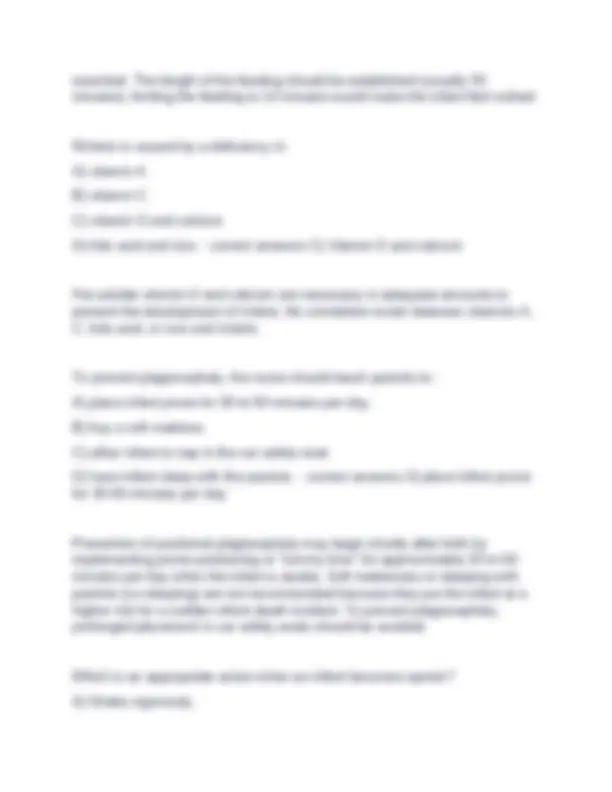


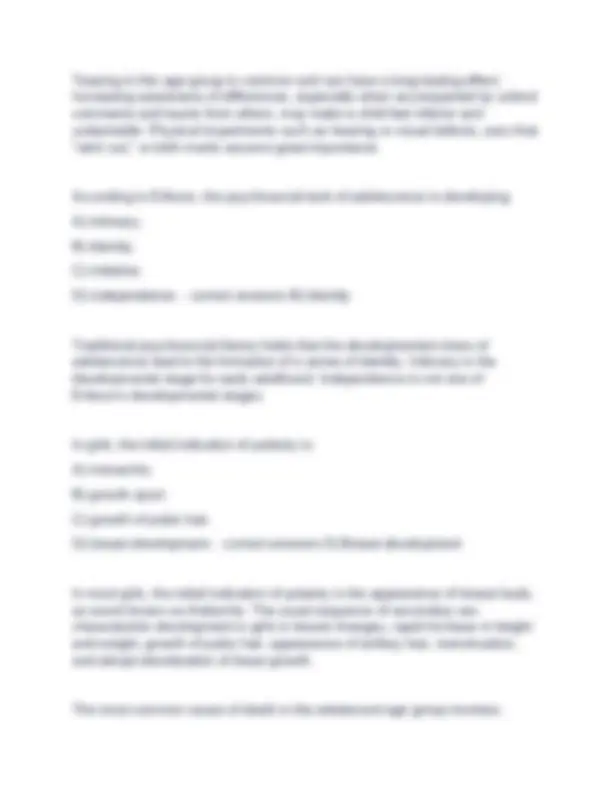

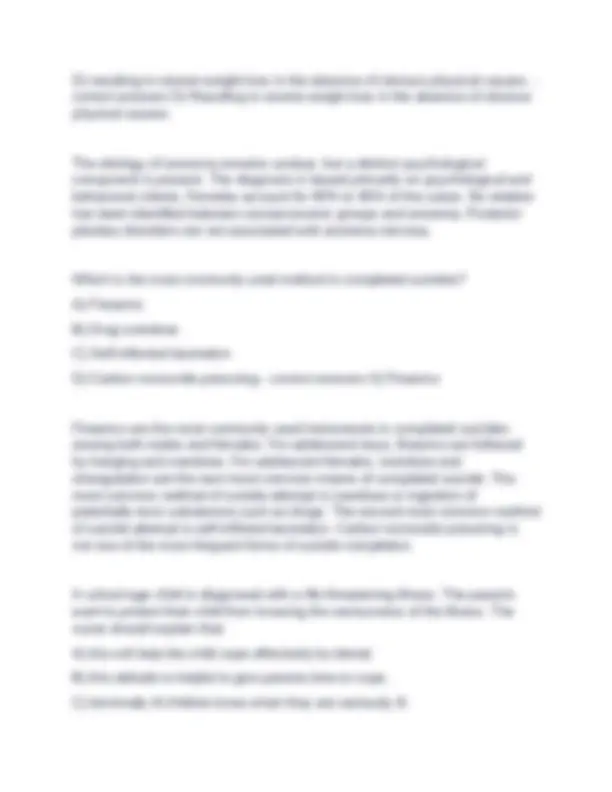
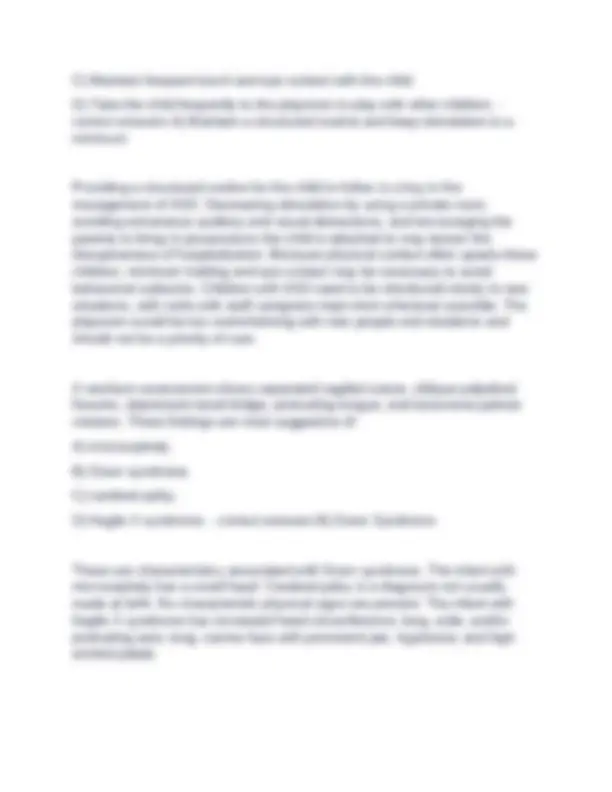
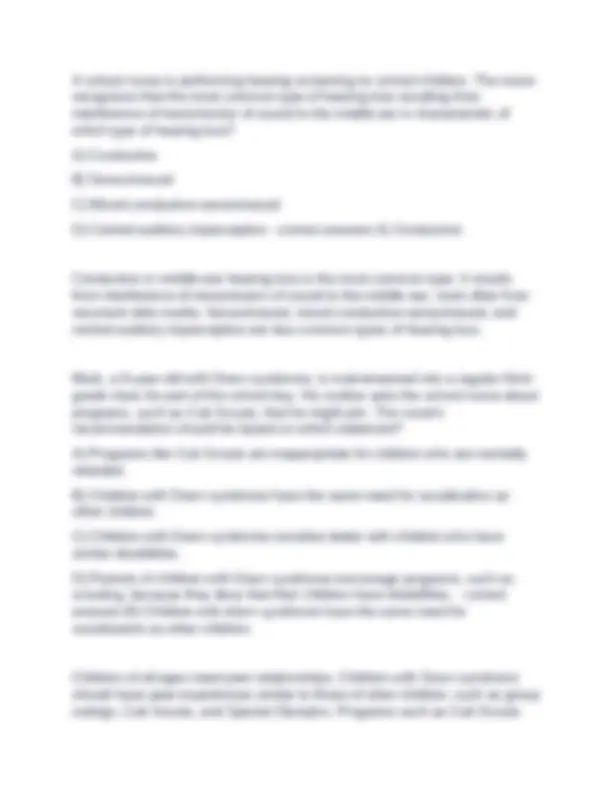
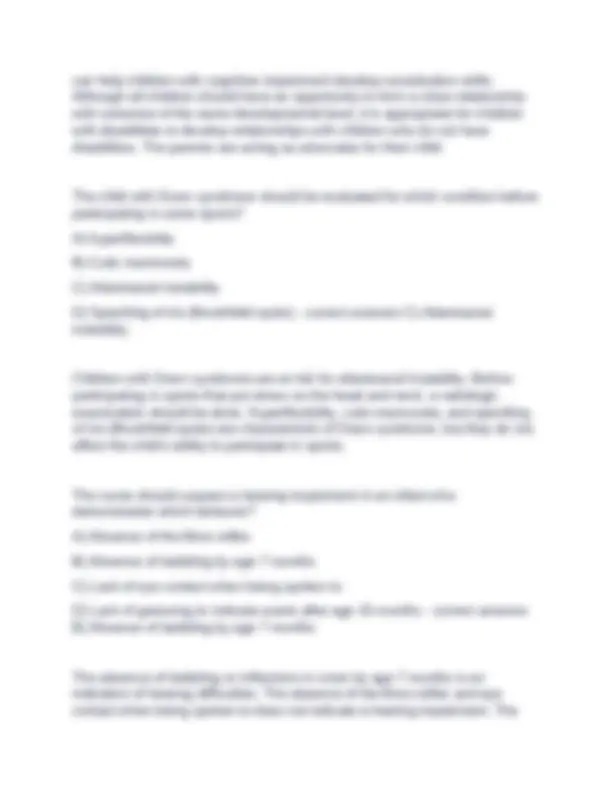





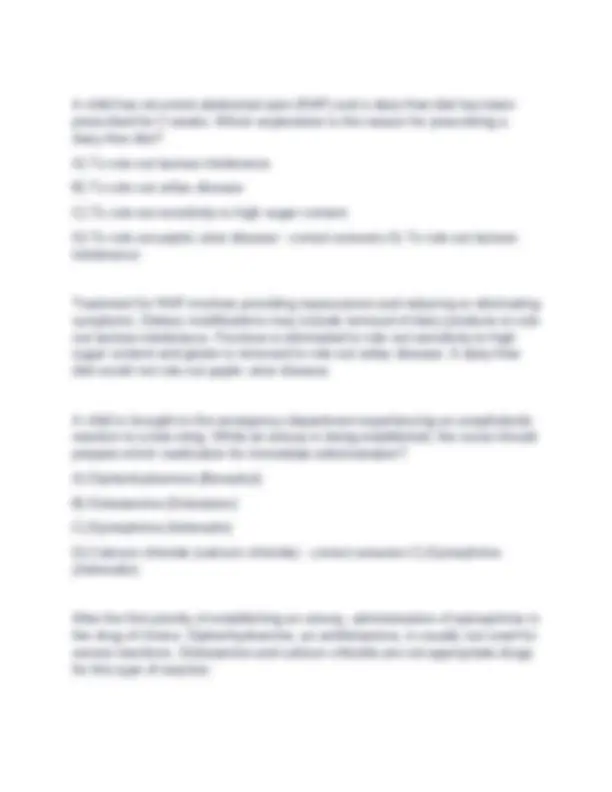
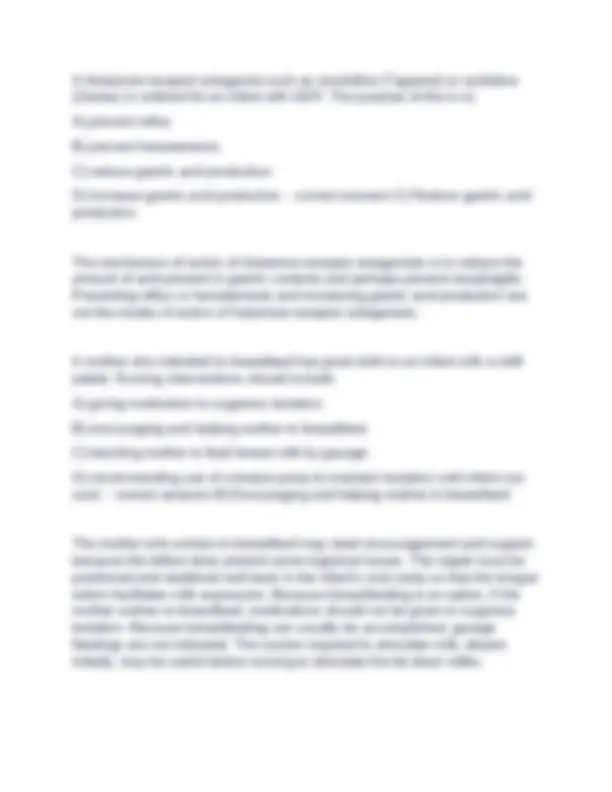

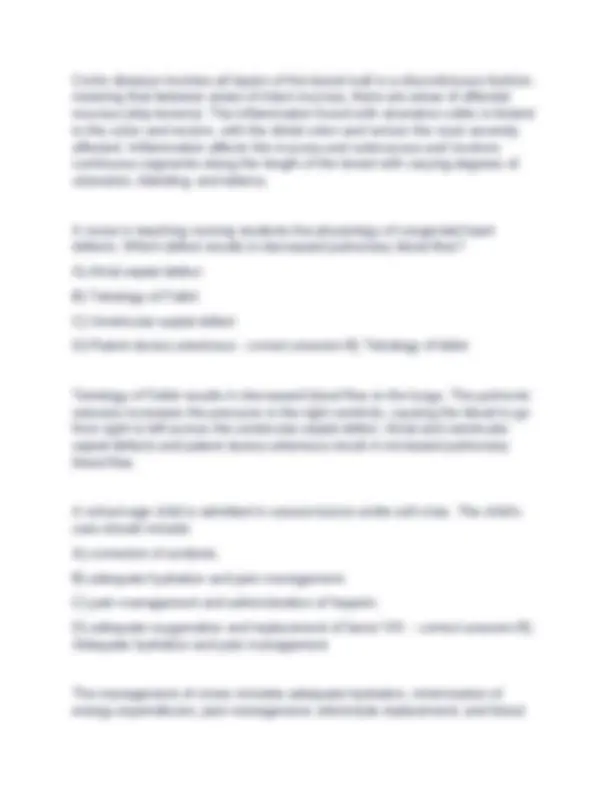


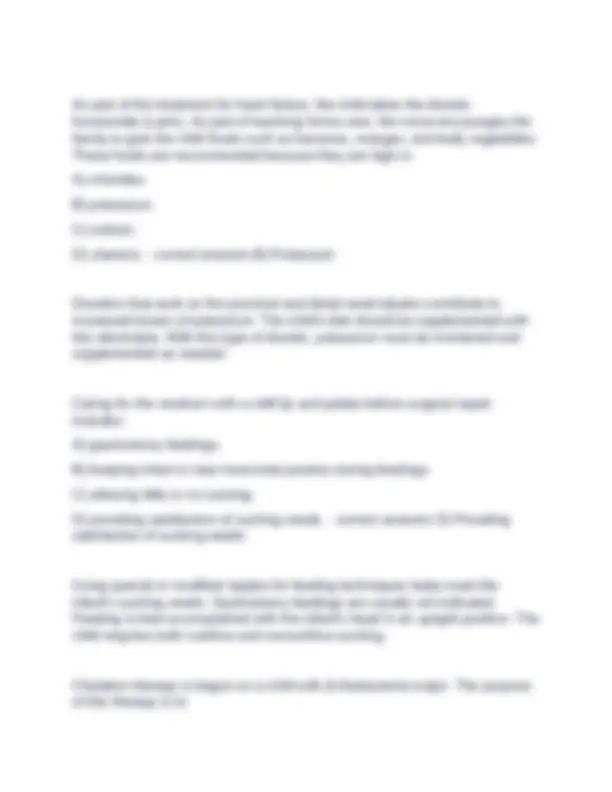


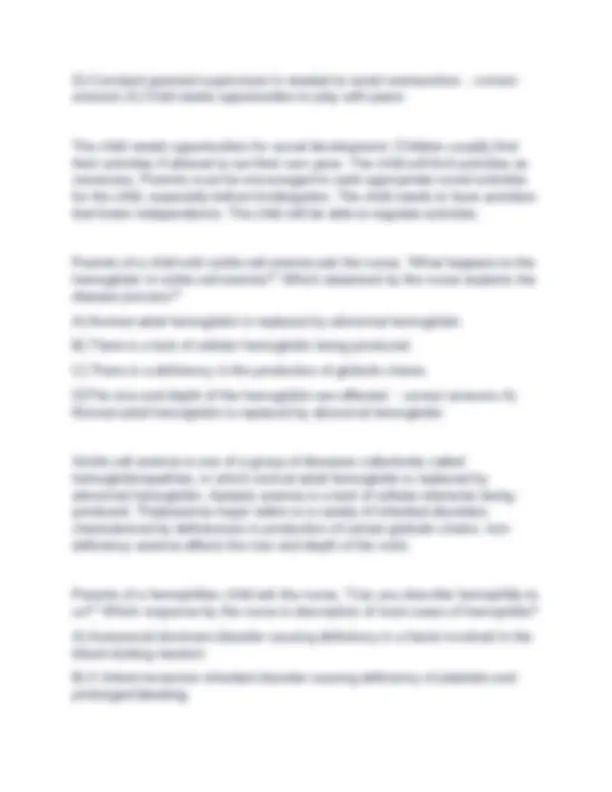
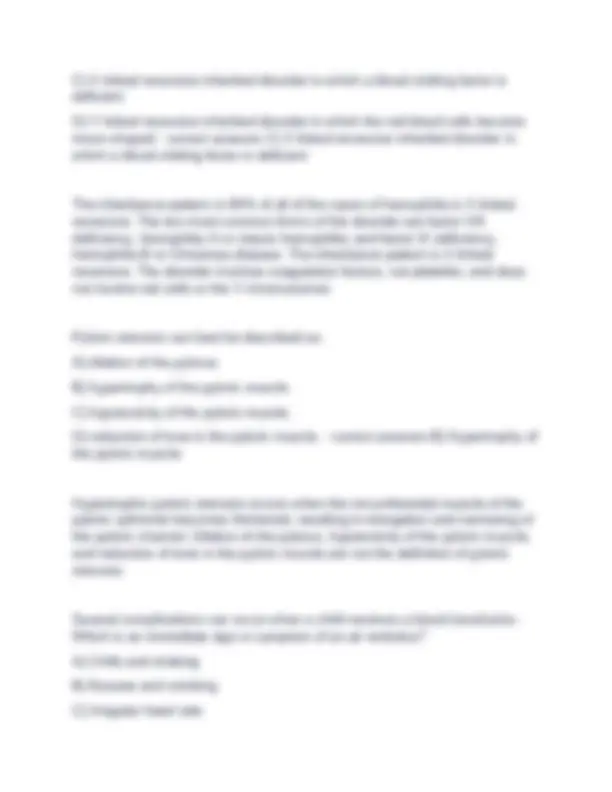

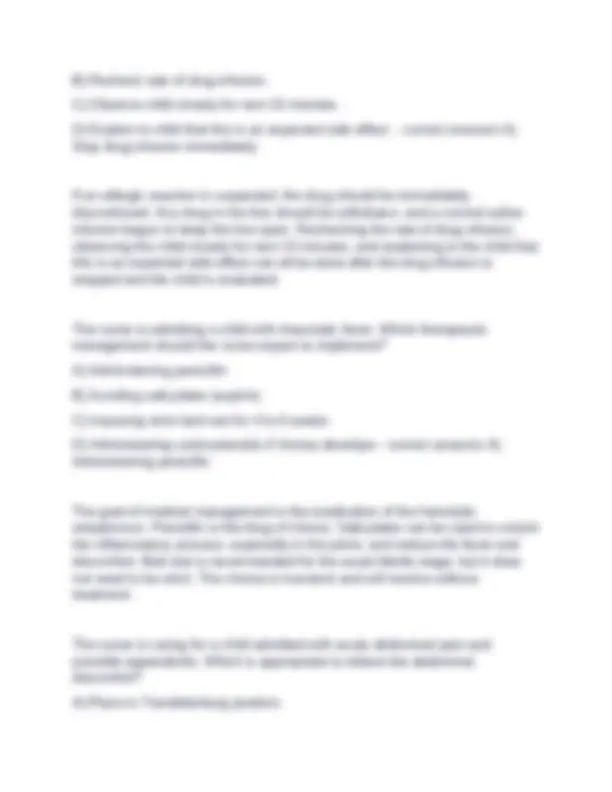

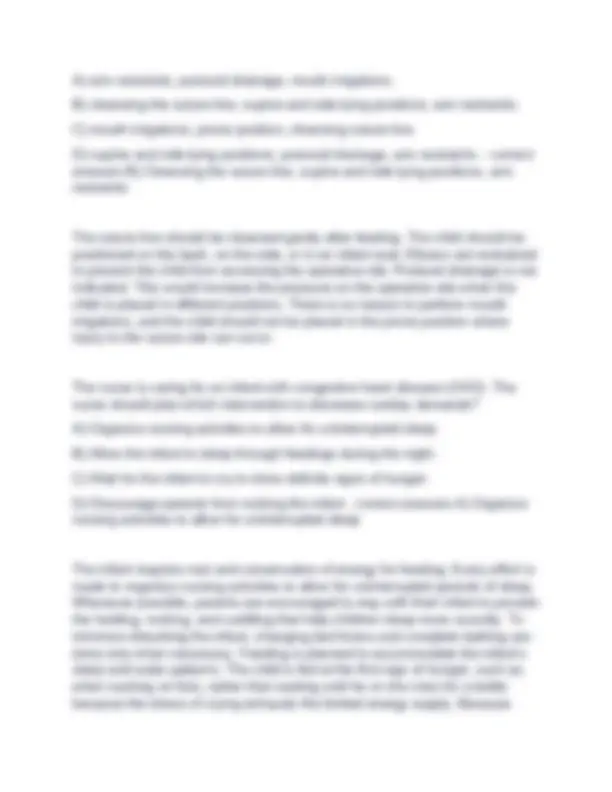
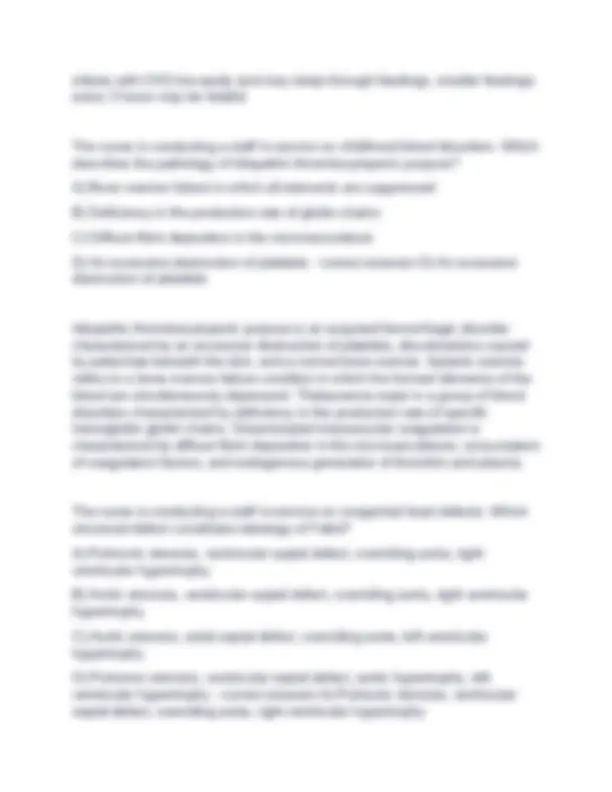

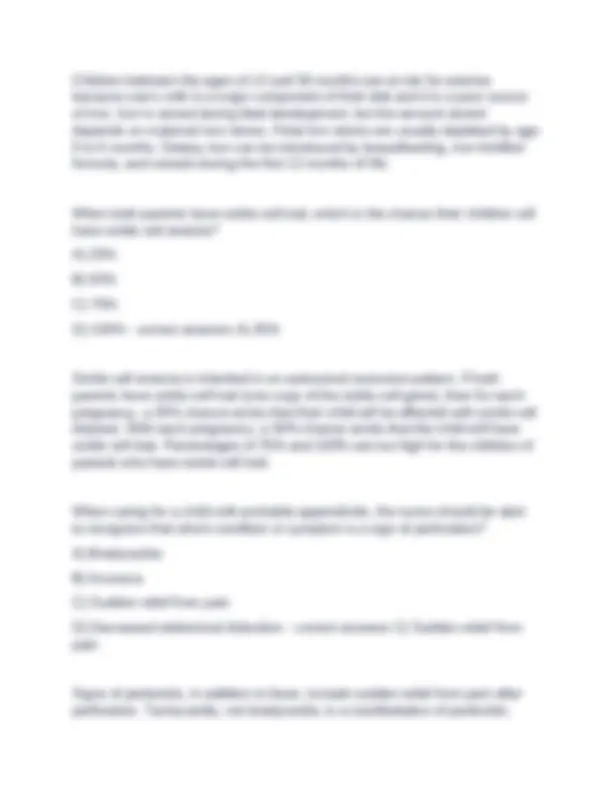
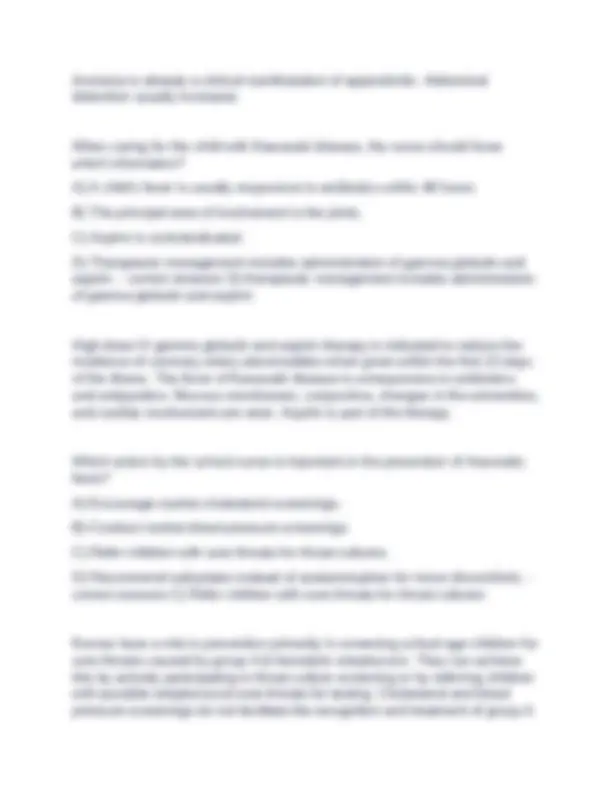
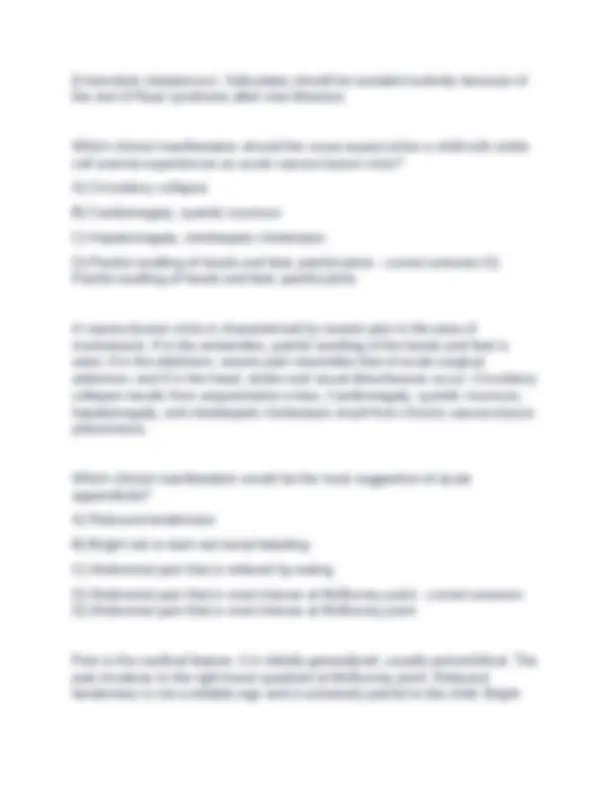

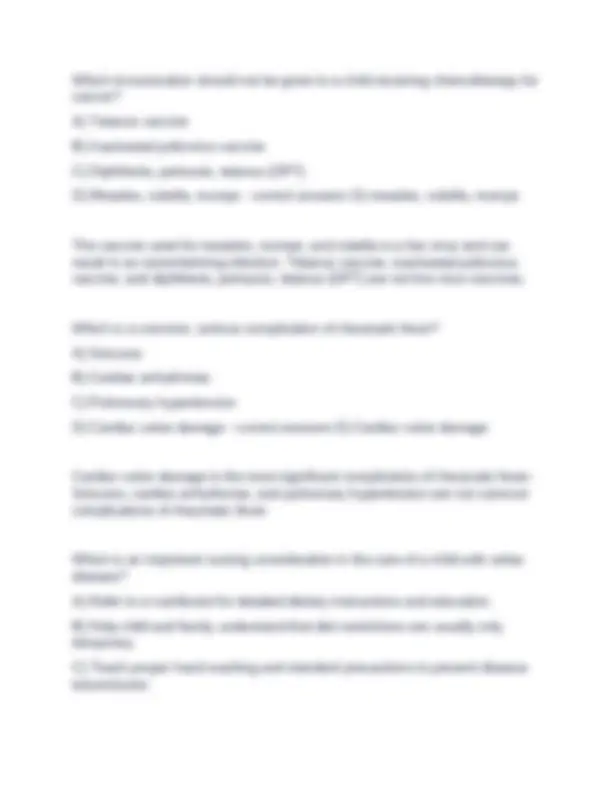
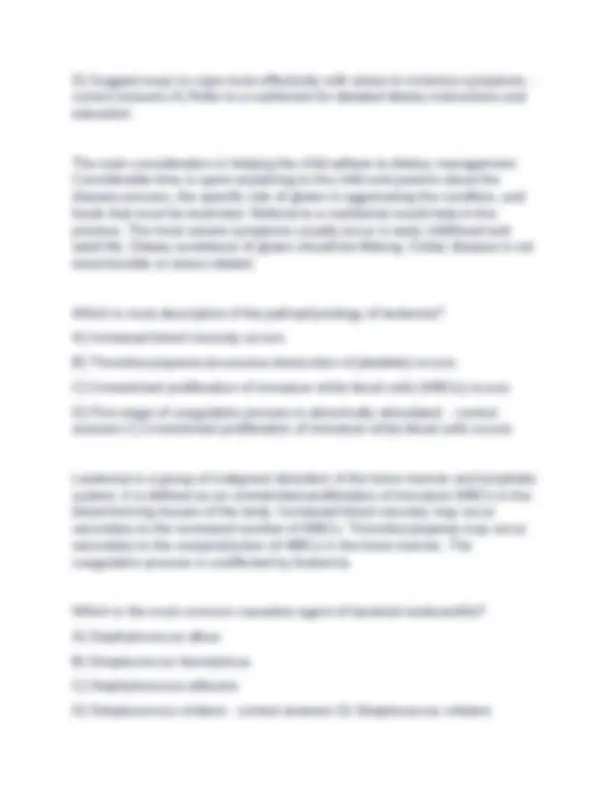
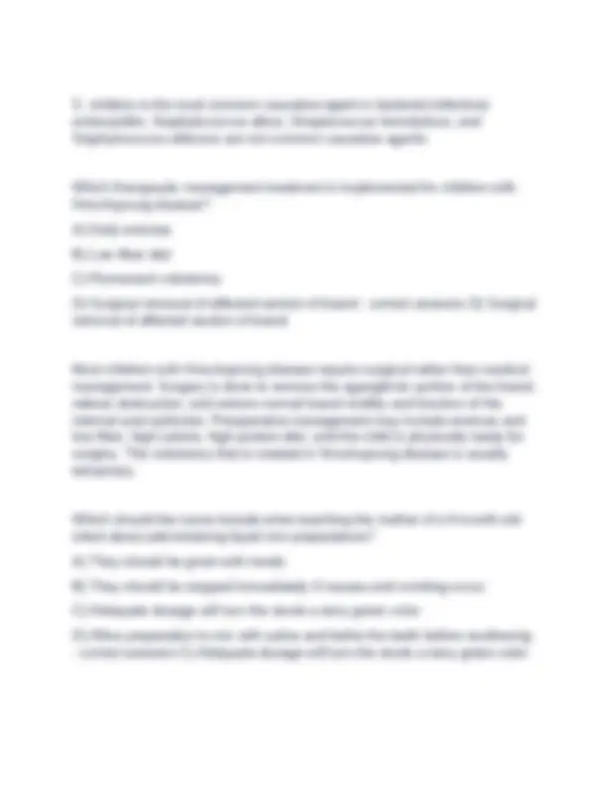
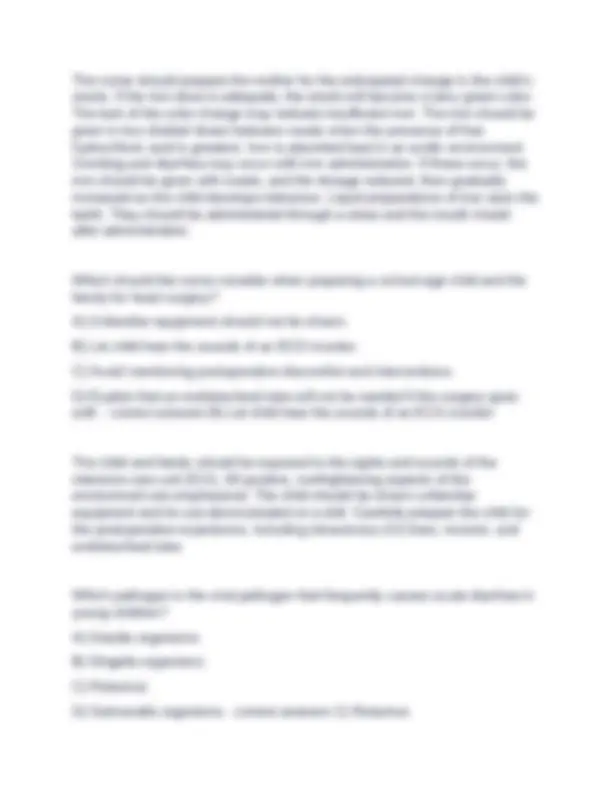
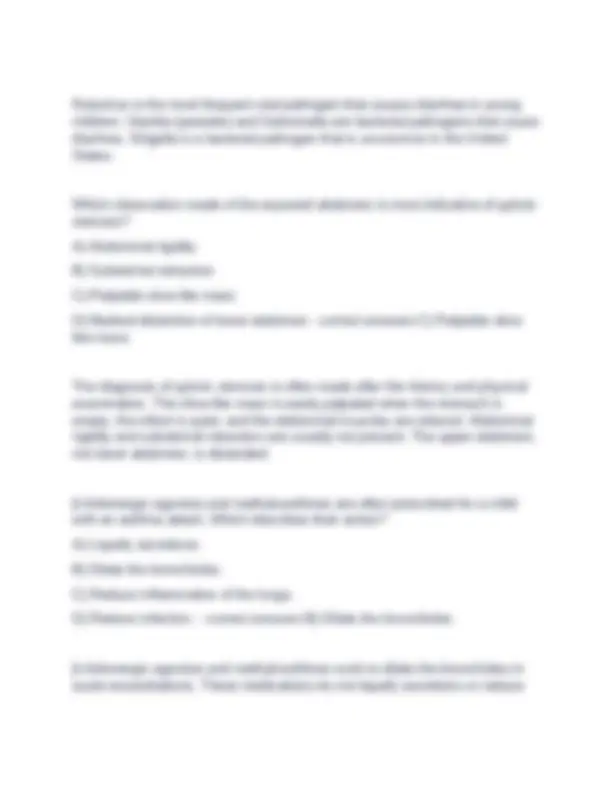
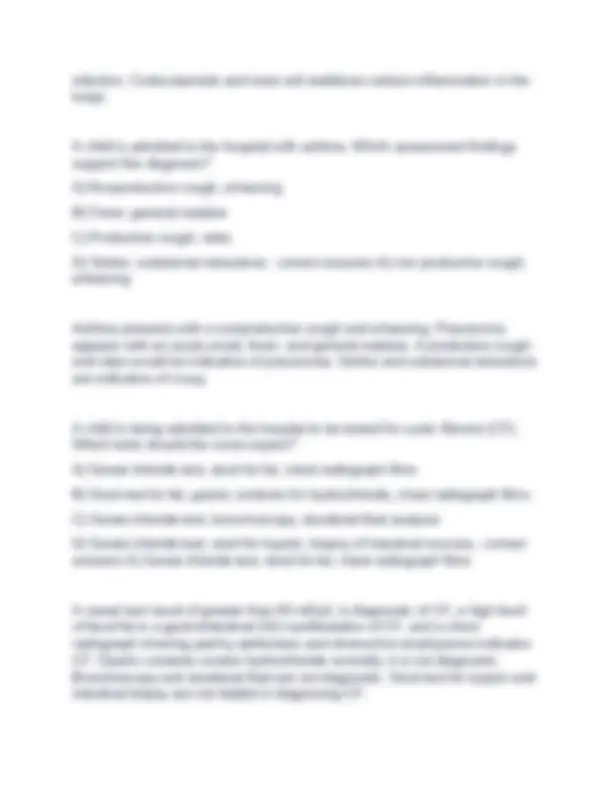
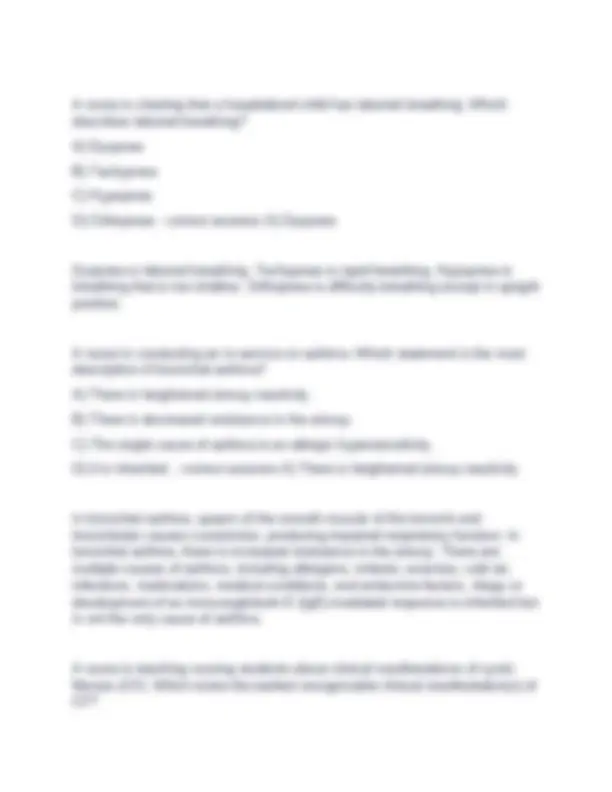



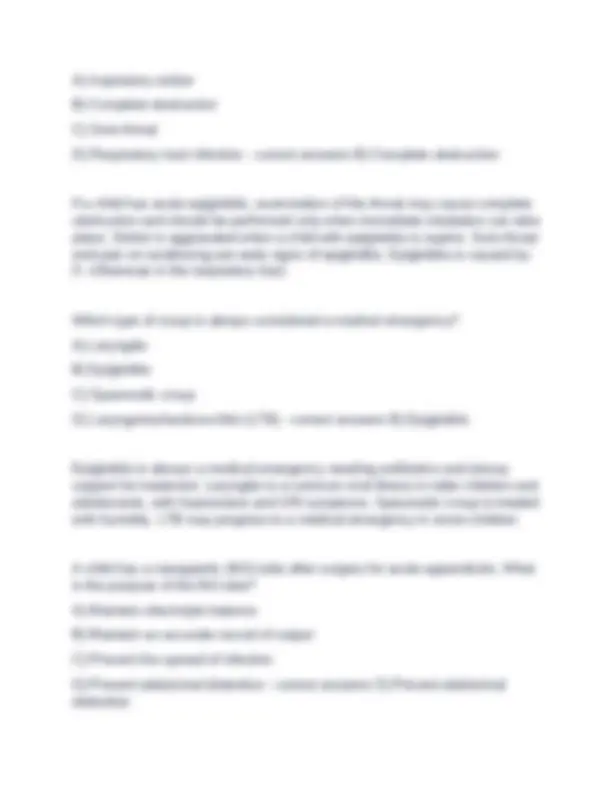
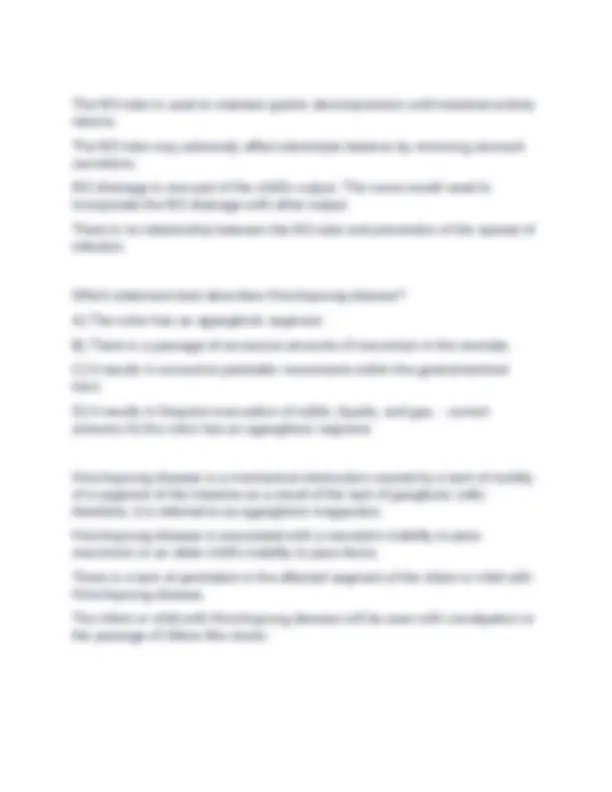


Study with the several resources on Docsity

Earn points by helping other students or get them with a premium plan


Prepare for your exams
Study with the several resources on Docsity

Earn points to download
Earn points by helping other students or get them with a premium plan
Community
Ask the community for help and clear up your study doubts
Discover the best universities in your country according to Docsity users
Free resources
Download our free guides on studying techniques, anxiety management strategies, and thesis advice from Docsity tutors
Peds Exam 1 and 2 Question and answer rated A+ 2025
Typology: Exams
1 / 58

This page cannot be seen from the preview
Don't miss anything!



















































A nurse on a pediatric unit is practicing family-centered care. Which is most descriptive of the care the nurse is delivering? A) Taking over total care of the child to reduce stress on the family B) Encouraging family dependence on health care systems C) Recognizing that the family is the constant in a child's life D) Excluding families from the decision-making process - correct answers C) Recognizing that the family is the constant in a child's life The three key components of family-centered care are respect, collaboration, and support. Family-centered care recognizes the family as the constant in the child's life. Taking over total care does not include the family in the process and may increase stress instead of reducing stress. The family should be enabled and empowered to work with the health care system. The family is expected to be part of the decision-making process. The nurse is preparing an in-service education to staff about atraumatic care for pediatric patients. Which intervention should the nurse include? A) Prepare the child for separation from parents during hospitalization by reviewing a video. B) Prepare the child before any unfamiliar treatment or procedure by demonstrating on a stuffed animal. C) Help the child accept the loss of control associated with hospitalization. D) Help the child accept pain that is connected with a treatment or procedure.
Preparing the child for any unfamiliar treatments, controlling pain, allowing privacy, providing play activities for expression of fear and aggression, providing choices, and respecting cultural differences are components of atraumatic care. In the provision of atraumatic care, the separation of child from parents during hospitalization is minimized. The nurse should promote a sense of control for the child. Preventing and minimizing bodily injury and pain are major components of atraumatic care. Which is the major cause of death for children older than 1 year? A) Cancer B) Heart disease C) Unintentional injuries D) Congenital anomalies - correct answers C) Unintentional injuries Unintentional injuries (accidents) are the leading cause of death after age 1 year through adolescence. Congenital anomalies are the leading cause of death in those younger than 1 year. Cancer ranks either second or fourth, depending on the age group, and heart disease ranks fifth in the majority of the age groups. Parents of a firstborn child are asking whether it is normal for their child to be extremely competitive. The nurse should respond to the parents that studies about the ordinal position of children suggest that firstborn children tend to: A) be praised less often. B) be more achievement oriented. C) be more popular with the peer group. D) identify with peer group more than parents. - correct answers B) Be more achievement oriented Firstborn children, like only children, tend to be more achievement-oriented.
first birthday; 14, 16, or 18 pounds is below what would be expected for an infant with a birth weight of 7 pounds. The nurse observes some children in the playroom. Which play situation exhibits the characteristics of parallel play? A) Kimberly and Amanda sharing clay to each make things B) Brian playing with his truck next to Kristina playing with her truck C) Adam playing a board game with Kyle, Steven, and Erich D) Danielle playing with a music box on her mother's lap - correct answers B) Brian playing with his truck next to Kristina playing with her truck Playing with trucks next to each other but not together is an example of parallel play. Both children are engaged in similar activities in proximity to each other; however, they are each engaged in their own play. Sharing clay to make things is characteristic of associative play. Friends playing a board game together is characteristic of cooperative play. A child playing with something by herself on her mother's lap is an example of solitary play. At what age should the nurse expect the anterior fontanel to close? A) 2 months B) 2 to 4 months C) 6 to 8 months D) 12 to 18 months - correct answers D) 12-18 months The anterior fontanel normally closes between ages 12 and 18 months. Two to 8 months is too early. The expected closure of the anterior fontanel occurs between ages 12 and 18 months; if it closes between ages 2 and 8 months, the child should be referred for further evaluation
The nurse is meeting a 5-year-old child for the first time and would like the child to cooperate during a dressing change. The nurse decides to do a simple magic trick using gauze. This should be interpreted as: A) inappropriate, because of child's age. B) a way to establish rapport. C) too distracting, when cooperation is important. D) acceptable, if there is adequate time. - correct answers B) A way to establish rapport A magic trick or other simple game may help alleviate anxiety for a 5-year-old. It is an excellent method to build rapport and facilitate cooperation during a procedure. Magic tricks appeal to the natural curiosity of young children. The nurse should establish rapport with the child. Failure to do so may cause the procedure to take longer and be more traumatic. What is the single most important factor to consider when communicating with children? A) The child's physical condition B) Presence or absence of the child's parent C) The child's developmental level D) The child's nonverbal behaviors - correct answers C) The child's developmental level The nurse must be aware of the child's developmental stage to engage in effective communication. The use of both verbal and nonverbal communication should be appropriate to the developmental level. Although the child's physical condition is a consideration, developmental level is much more important. The parents' presence is important when communicating with young children but may be detrimental when speaking with adolescents. Nonverbal behaviors will vary in importance, based on the child's developmental level.
Which information should the nurse give a mother regarding the introduction of solid foods during infancy? A) Solid foods should not be introduced until 8 to 10 months, when the extrusion reflex begins to disappear. B) Foods should be introduced one at a time, at intervals of 4 to 7 days. C) Solid foods can be mixed in a bottle to make the transition easier for the infant. D) Fruits and vegetables should be introduced into the diet first. - correct answers B) Foods should be introduced one at a time, at intervals of 4-7 days One food item is introduced at intervals of 4 to 7 days to allow the identification of food allergies. Solid foods can be introduced earlier. The extrusion reflex usually disappears by age 6 months. Mixing solid foods in a bottle has no effect on the transition to solid food. Iron-fortified cereal should be the first solid food introduced into the infant's diet. A nurse is preparing to feed a 12-month-old infant with failure to thrive. Which intervention should the nurse implement? A) Provide stimulation during feeding. B) Avoid being persistent during feeding time. C) Limit feeding time to 10 minutes. D) Maintain a face-to-face posture with the infant during feeding. - correct answers D) Maintain a face to face posture with the infant during feeding The nurse preparing to feed an infant with failure to thrive should maintain a face-to-face posture with the infant when possible. Encourage eye contact and remain with the infant throughout the meal. Stimulation is not recommended; a quiet, unstimulating atmosphere should be maintained. Persistence during feeding may need to be implemented. Calm perseverance through 10 to 15 minutes of food refusal will eventually diminish negative behavior. Although forced feeding is avoided, "strictly encouraged" feeding is
essential. The length of the feeding should be established (usually 30 minutes); limiting the feeding to 10 minutes would make the infant feel rushed. Rickets is caused by a deficiency in: A) vitamin A. B) vitamin C. C) vitamin D and calcium. D) folic acid and iron. - correct answers C) Vitamin D and calcium Fat-soluble vitamin D and calcium are necessary in adequate amounts to prevent the development of rickets. No correlation exists between vitamins A, C, folic acid, or iron and rickets. To prevent plagiocephaly, the nurse should teach parents to: A) place infant prone for 30 to 60 minutes per day. B) buy a soft mattress. C) allow infant to nap in the car safety seat. D) have infant sleep with the parents. - correct answers A) place infant prone for 30-60 minutes per day Prevention of positional plagiocephaly may begin shortly after birth by implementing prone positioning or "tummy time" for approximately 30 to 60 minutes per day when the infant is awake. Soft mattresses or sleeping with parents (co-sleeping) are not recommended because they put the infant at a higher risk for a sudden infant death incident. To prevent plagiocephaly, prolonged placement in car safety seats should be avoided. Which is an appropriate action when an infant becomes apneic? A) Shake vigorously.
A) Punish the child. B) Provide more attention. C) Ask child not always to say "no." D) Reduce the opportunities for a "no" answer. - correct answers D) Reduce the opportunities for a "no" answer The nurse should suggest to the parent that questions be phrased with realistic choices rather than yes or no answers. This provides the toddler with a sense of control and reduces the opportunity for negativism. Negativism is not an indication of stubbornness or insolence and should not be punished. The negativism is not a function of attention; the child is testing limits to gain an understanding of the world. The toddler is too young to be asked to not always say "no." A 4-year-old child tells the nurse that she does not want another blood sample drawn because "I need all my insides, and I don't want anyone taking them out." Which is the nurse's best interpretation of this? A) Child is being overly dramatic. B) Child has a disturbed body image. C) Preschoolers have poorly defined body boundaries. D) Preschoolers normally have a good understanding of their bodies. - correct answers C) Preschoolers have poorly defined body boundaries Preschoolers have little understanding of body boundaries, which leads to fears of mutilation. The child is not capable of being dramatic at 4 years of age. She truly has fear. Body image is just developing in the school-age child. Preschoolers do not have good understanding of their bodies. The nurse is caring for a hospitalized 4-year-old boy. His parents tell the nurse that they will be back to visit at 6 PM. When the child asks the nurse when his parents are coming, the nurse's best response is
A) "They will be here soon." B) "They will come after dinner." C) "Let me show you on the clock when 6 PM is." D) "I will tell you every time I see you how much longer it will be." - correct answers B) "They will come after dinner" A 4-year-old child understands time in relation to events such as meals. Children perceive "soon" as a very short time. The nurse may lose the child's trust if his parents do not return in the time he perceives as "soon." Children cannot read or use a clock for practical purposes until age 7 years. I will tell you every time I see you how much longer it will be assumes the child understands the concepts of hours and minutes, which are not developed until age 5 or 6 years. A 3-month-old infant dies shortly after arrival to the emergency department. The infant has subdural and retinal hemorrhages but no external signs of trauma. The nurse should suspect: A) unintentional injury. B) shaken-baby syndrome. C) sudden infant death syndrome (SIDS). D) congenital neurologic problem. - correct answers B) Shaken-baby syndrome Shaken-baby syndrome causes internal bleeding but may have no external signs. Unintentional injury would not cause these injuries. SIDS and congenital neurologic problems would not appear this way. A nurse is assessing a child and notes Koplik spots. In which of these communicable diseases are Koplik spots present? A) Rubella
Teasing in this age group is common and can have a long-lasting effect. Increasing awareness of differences, especially when accompanied by unkind comments and taunts from others, may make a child feel inferior and undesirable. Physical impairments such as hearing or visual defects, ears that "stick out," or birth marks assume great importance. According to Erikson, the psychosocial task of adolescence is developing: A) intimacy. B) identity. C) initiative. D) independence. - correct answers B) Identity Traditional psychosocial theory holds that the developmental crises of adolescence lead to the formation of a sense of identity. Intimacy is the developmental stage for early adulthood. Independence is not one of Erikson's developmental stages. In girls, the initial indication of puberty is: A) menarche. B) growth spurt. C) growth of pubic hair. D) breast development. - correct answers D) Breast development In most girls, the initial indication of puberty is the appearance of breast buds, an event known as thelarche. The usual sequence of secondary sex characteristic development in girls is breast changes, rapid increase in height and weight, growth of pubic hair, appearance of axillary hair, menstruation, and abrupt deceleration of linear growth. The most common cause of death in the adolescent age group involves:
A) drownings. B) firearms. C) drug overdoses. D) motor vehicles. - correct answers D) Motor vehicles Forty percent of all adolescent deaths in the United States are the result of motor vehicle accidents. Drownings, firearms, and drug overdoses are major concerns in adolescence but are not the most common cause of death. An adolescent teen has bulimia. Which assessment finding should the nurse expect to assess? A) Diarrhea B) Amenorrhea C) Cold intolerance D) Erosion of tooth enamel - correct answers D) Erosion of tooth enamel Some of the signs of bulimia include erosion of tooth enamel, increased dental caries from vomited gastric acid, throat complaints, fluid and electrolyte disturbances, and abdominal complaints from laxative abuse. Diarrhea is not a result of the vomiting. It may occur in patients with bulimia who also abuse laxatives. Amenorrhea and cold intolerance are characteristics of anorexia nervosa, which some bulimics have. These symptoms are related to the extreme low weight. Anorexia nervosa may best be described as: A) occurring most frequently in adolescent males. B) occurring most frequently in adolescents from lower socioeconomic groups. C) resulting from a posterior pituitary disorder.
D) terminally ill children usually choose not to discuss the seriousness of their illness. - correct answers C) Terminally ill children know when they are seriously ill The child needs honest and accurate information about the illness, treatments, and prognosis. Children, even at a young age, realize that something is seriously wrong and that it involves them. The nurse should help the parents understand the importance of honesty. Nursing interventions to help the siblings of a child with special needs cope include: A) explaining to the siblings that embarrassment is unhealthy. B) encouraging the parents not to expect siblings to help them care for the child with special needs. C) providing information to the siblings about the child's condition only as they request it. D) suggesting to the parents ways of showing gratitude to the siblings who help care for the child with special needs. - correct answers D) Suggesting to the parents ways of showing gratitude to the siblings who help care for the child with special needs. The presence of a child with special needs in a family will change the family dynamic. Siblings may be asked to take on additional responsibilities to help the parents to care for the child. The parents should show gratitude, such as an increase in allowance, special privileges, and verbal praise. Embarrassment may be associated with having a sibling with a chronic illness or disability. Parents must be able to respond in an appropriate manner without punishing the sibling. The parents may need assistance with the care of the child. Most siblings are positive about the extra responsibilities. The siblings need to be informed about the child's condition before a nonfamily member does so. The parents do not want the siblings to fantasize about what is wrong with the child.
Parents are asking about an early intervention program for their child who has special needs. The nurse relates that this program is for which age of child? A) Birth to 1 year of age B) Birth to 3 years of age C) Ages 1 to 4 D) Ages 4 and 5 - correct answers B) Birth to 3 years of age A variety of supplemental programs have been designed in the school system to accommodate special needs, both at school age and younger, through early intervention, which consists of any sustained and systematic effort to assist children from birth to age 3 years with disabilities and those who are developmentally vulnerable. Which term best describes a multidisciplinary approach to the management of a terminal illness that focuses on symptom control and support? A) Dying care B) Curative care C) Restorative care D) Palliative care - correct answers D) Palliative care This is one of the definitions of palliative care. The goal of palliative care is the achievement of the highest possible quality of life for patients and their families. A child with autism spectrum disorder (ASD) is admitted to the hospital with pneumonia. The nurse should plan which priority intervention when caring for the child? A) Maintain a structured routine and keep stimulation to a minimum. B) Place child in a room with a roommate of the same age.
A school nurse is performing hearing screening on school children. The nurse recognizes that the most common type of hearing loss resulting from interference of transmission of sound to the middle ear is characteristic of which type of hearing loss? A) Conductive B) Sensorineural C) Mixed conductive-sensorineural D) Central auditory imperceptive - correct answers A) Conductive Conductive or middle-ear hearing loss is the most common type. It results from interference of transmission of sound to the middle ear, most often from recurrent otitis media. Sensorineural, mixed conductive-sensorineural, and central auditory imperceptive are less common types of hearing loss. Mark, a 9-year-old with Down syndrome, is mainstreamed into a regular third- grade class for part of the school day. His mother asks the school nurse about programs, such as Cub Scouts, that he might join. The nurse's recommendation should be based on which statement? A) Programs like Cub Scouts are inappropriate for children who are mentally retarded. B) Children with Down syndrome have the same need for socialization as other children. C) Children with Down syndrome socialize better with children who have similar disabilities. D) Parents of children with Down syndrome encourage programs, such as scouting, because they deny that their children have disabilities. - correct answers B) Children with down syndrome have the same need for socialization as other children. Children of all ages need peer relationships. Children with Down syndrome should have peer experiences similar to those of other children, such as group outings, Cub Scouts, and Special Olympics. Programs such as Cub Scouts
can help children with cognitive impairment develop socialization skills. Although all children should have an opportunity to form a close relationship with someone of the same developmental level, it is appropriate for children with disabilities to develop relationships with children who do not have disabilities. The parents are acting as advocates for their child. The child with Down syndrome should be evaluated for which condition before participating in some sports? A) hyperflexibility B) Cutis marmorata C) Atlantoaxial instability D) Speckling of iris (Brushfield spots) - correct answers C) Atlantoaxial instability Children with Down syndrome are at risk for atlantoaxial instability. Before participating in sports that put stress on the head and neck, a radiologic examination should be done. Hyperflexibility, cutis marmorata, and speckling of iris (Brushfield spots) are characteristic of Down syndrome, but they do not affect the child's ability to participate in sports. The nurse should suspect a hearing impairment in an infant who demonstrates which behavior? A) Absence of the Moro reflex B) Absence of babbling by age 7 months C) Lack of eye contact when being spoken to D) Lack of gesturing to indicate wants after age 15 months - correct answers B) Absence of babbling by age 7 months The absence of babbling or inflections in voice by age 7 months is an indication of hearing difficulties. The absence of the Moro reflex and eye contact when being spoken to does not indicate a hearing impairment. The